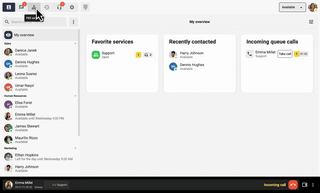How often do you review your company’s digital security? Here’s how you can do a quick security check in just 10 minutes.
Regardless of size, maturity or industry, almost all businesses can benefit from improving their digital security. At Telavox, we are constantly working on our digital security, be it internally or for our customers. For example, we have an integration with BankID. This allows companies that use our solution to offer their customers the most secure service possible.
While larger companies can let IT professionals and security experts do the job, this is not always possible for all businesses. The digital landscape is constantly changing and new security threats emerge daily. That’s why it’s good to regularly check whether your business is prepared and protected.
But maintaining a company’s digital security can be a full-time job and requires a lot of knowledge and experience. However, it is possible to carry out a simple audit in a few minutes to find out what can be improved to prevent potential attacks.
What is a security check?
When we talk about a review of your security, we simply mean a general review of different aspects of your company’s security. If everything turns out to be correct – great! But if some things aren’t being done properly, it’s good to find out now, before it’s too late.
Who should do a security check?
Companies that have the resources may have an external expert review their security on a regular basis, or they may have staff who review security on a daily basis.
It’s usually up to the IT manager or similar to keep an eye on things, but every employee should make sure they follow those rules. Whoever is authorized as an administrator should pay special attention to the tools you use and who has access to them.
How often should you review your digital security?
Depending on the scope of the review, an annual check may be sufficient if it is thorough. A faster one can be done on a monthly basis.
A good rule of thumb is to do a quick survey when onboarding new staff or acquiring new software. This is when you (hopefully) review who should have access to what. While you’re at it, it might be worth checking that everything is as it should be for the rest of your colleagues.
How to do a quick security check:
Doing a complete survey of your entire system is a complex process and not something we will go through here. Instead, let’s focus on the things you can do relatively quickly on a regular basis to prevent major problems. Here are some things you can check in just ten minutes to feel a little more confident.
1. Review your company’s policies
First of all, to see if your security is in line with your rules, you need to know what they are. If you have specific guidelines, you may want to review them. There are two benefits to this: firstly, you have your processes in mind when you do the review, and secondly, you may see something that needs to be changed.
You may require all new employees to visit the office to sign their contract. But in today’s world of hybrid and remote working, this may not be necessary.
Instead of ignoring old rules, it is best to find them and come up with new solutions. It will make things easier for you in the long run.
2. update your passwords
Security experts advise us to have long passwords that are both complex and easy to remember, to change them regularly and to have different passwords for different services.
In real life, few people follow this advice. Nevertheless, it is worth taking a look at your passwords at regular intervals and making sure they are secure enough. Many companies have gotten into trouble because systems they said were secure were protected by passwords like “hello123!”.
Review your login credentials, update weak ones and try to use different passwords to reduce the risk of your tools falling into the wrong hands.
If you think one of your passwords may have been shared within your company and you’re not sure who is using it, you may want to change it. If you really need to share a single account, ask an IT expert if you can get a service that manages your passwords securely (like 1Password, for example).
Tips! Remember to change passwords when an employee leaves, or when they no longer need access to a particular tool.
3. review who has access and authorization
Hopefully, you won’t have to share login details with anyone. Most tools support multiple logins and accounts and allow you to manage permissions depending on who should have access to what.
It’s a good idea to regularly review who has access, especially when you’ve been using the tool for a while. It’s common for employees to start with basic access, but then they may need administrator rights to do something specific. Before you know it, a lot of employees have access to the most sensitive parts of the tool that they don’t really need.
Review who in your team has access to what and whether they really need to access all the features. More and more tools and platforms have made it easier to manage rights in detail. This allows you to turn on and off specific features for different employees.
If you haven’t looked at this for a while, it can be useful to see who can do what in the tools you use. This is especially important for those who hold customer information or things related to finance and payments.
However, this is not something you necessarily need to review every time you do a quick security check, but it is good practice to check when you add a new user.
4. Review the security of your website
Website security can be quite complicated, but most platforms have gotten better at notifying you of problems in an easy-to-understand way. For example, they can detect suspicious login attempts and notify you so you can check whether they are genuine or not. If you see a login attempt from a location that doesn’t match where you have employees, it could be that your data has been leaked – you need to act immediately.
Reviewing the security of your website also has other benefits. You may find malicious links. These are not directly linked to the security of a website, but can damage your online reputation and make it harder for customers to find you.
Malicious links are links to your website that come from suspicious or bad websites. You can try to remove these so that search engines no longer associate you with the negative source.
Tip! These tasks do not have to be done by managers only. Ask your team members to regularly review your security procedures and update their passwords to keep you safe. This is good as it ensures that all employees are aware of their digital security responsibilities. Make it part of your company culture.
Executive summary
Taking a quick look at your company’s digital security can save you a lot of trouble in the long run. It doesn’t have to be a big deal. Take 10 minutes to do a security check on a regular basis. It’s a great way to prevent small things from potentially becoming big problems for your business.

